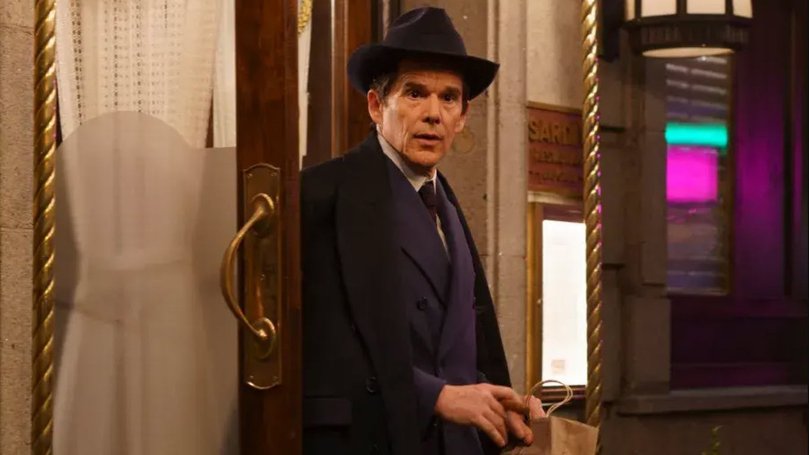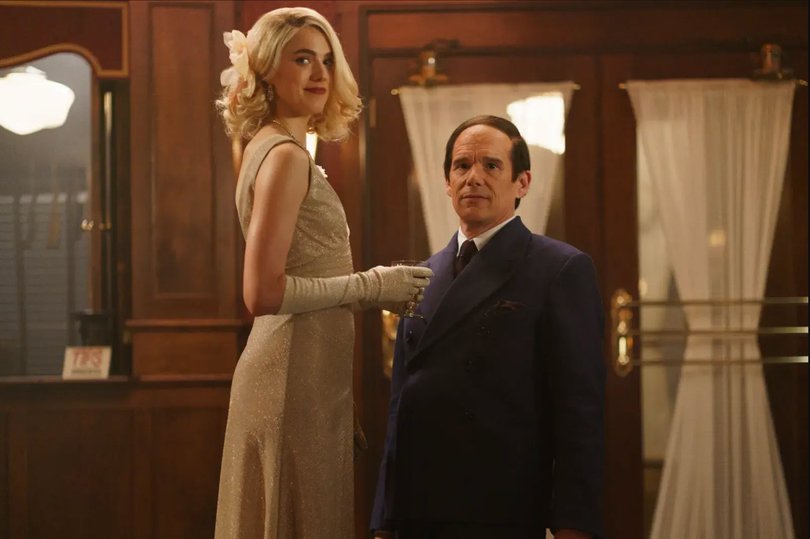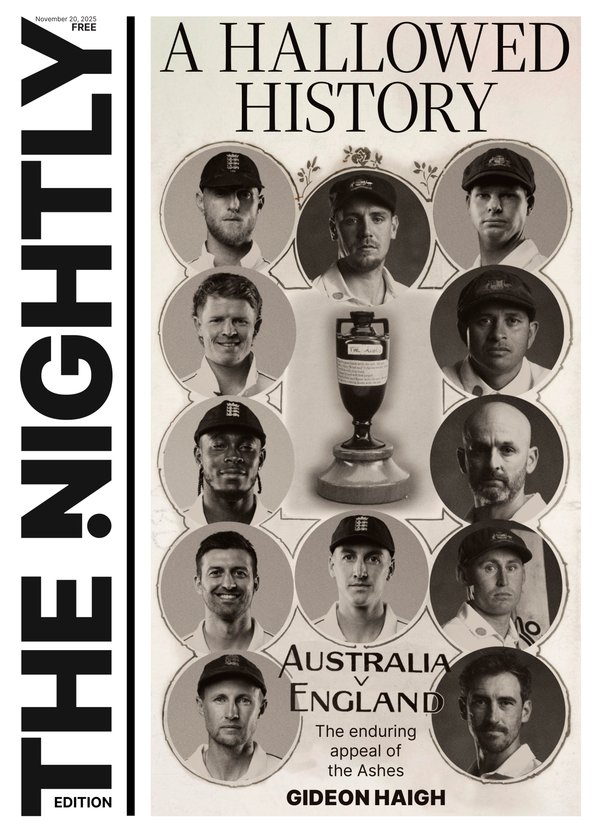The dramatic transformation Ethan Hawke underwent for Blue Moon

Before Rodgers and Hammerstein, there was Rodgers and Hart.
The songwriting duo, consisting of composer Richard Rodgers and lyricist Lorenz Hart, wrote hundreds of tunes together in the early 20th century, including the 1930s hits Blue Moon and My Funny Valentine.
They collaborated on more than two dozen stage musicals. But as Rodgers’ star continued to rise through a second partnership with Oscar Hammerstein II, Hart’s began to fade. The witty talker suffered from alcoholism and depression, likely worsened by pressure to suppress his homosexuality, and died of pneumonia at 48.
Sign up to The Nightly's newsletters.
Get the first look at the digital newspaper, curated daily stories and breaking headlines delivered to your inbox.
By continuing you agree to our Terms and Privacy Policy.Filmmaker Richard Linklater had long seen great tragicomic potential in a movie about the waning days of Hart’s abbreviated life — and about a decade ago, he mentioned it to his frequent collaborator Ethan Hawke.
Hawke latched onto the concept immediately, but Linklater felt that the actor, despite being in his mid-40s at the time, seemed too young to embody the character: “Hart was an old 48 when he died,” Linklater said in a recent interview. So they chatted about it for a decade, meeting periodically with screenwriter Robert Kaplow to rehash the story.
“Most directors would just cast somebody else,” Hawke said. “For some reason, he saw something inside of me that was dying to get out through this part, and (he) was willing to wait and use the time to keep making the material better.”
Their film, Blue Moon, is now in theatres. It takes place over a single night in New York when Hart (Hawke) lingers at the bar of the Broadway institution Sardi’s before Rodgers (Andrew Scott) arrives to celebrate the opening of Oklahoma!, his first musical with Hammerstein (Simon Delaney). Hart, devastated by his irrelevance, derides the new production — a certified hit — while oozing with jealousy. His drunken musings to the bartender (Bobby Cannavale) reflect the fragility of fame and fortune.
Hawke undergoes a stark transformation to become this pitiful figure, not only evoking pathos through his pained verbal daggers but in his reduced stature as well. The movie star, who stands 5-foot-10, plays Hart as a man embarrassed by his balding head and 5-foot height.
“Ultimately, it’s a deductive process: We’re taking away Ethan and replacing him with Larry Hart’s brain,” Linklater said. “He’s so diminished. It’s a different world when you’re looking up at everybody like that and people are looking down at you — literally.”
To get in character physically, Hawke worked with makeup artist David Atherton, who previously helped Hawke turn into abolitionist John Brown for the 2020 miniseries The Good Lord Bird, and costume designer Consolata Boyle.

“In the last 10 years — the years I’ve been meditating on this film — I got more and more interested in what people call character acting,” Hawke said. “I started getting interested in hair and makeup and vocal work, the different ways a human can move.”
The actor shaved the top of his head to play Hart, and Atherton fitted him with a thinning hair piece that blended into the sides of his real hair. While referencing archival photos, Atherton said he noticed the lyricist had dark eyes that were almost “shark like,” so they ordered sets of dark brown contact lenses to mask Hawke’s blue irises. The darkened color, paired with the shadows Atherton added to Hawke’s eye sockets, gave the actor’s face a more weathered appearance without using any prostheses.
“We just tried to grasp at the essence . . . of the character, but not make it look like a failed attempt at re-creating the look of this guy, you know?” Atherton said. “And then Ethan’s acting would do the rest in terms of suspending the audience’s disbelief.”
The production enlisted Hawke’s friend and sometimes collaborator Latham Gaines (who scored Hawke’s 2023 film “Wildcat”) to work as a height consultant and help dock 10 inches from the actor’s stature. Hawke walked short distances with his knees bent when they were out of frame. In other scenes, his co-stars stood on apple boxes so they loomed over him. The most elaborate practical effect involved Susie Cullen’s production design team building trenches into the soundstage for Hawke to stand in so he could appear much shorter than everyone else on screen.

“We weren’t going to do visual effects,” Linklater said. “It was intricate. A pain in the ass, for sure.”
When Hart stands at Sardi’s to greet his 5-foot-8 friend Elizabeth Weiland (Margaret Qualley), his head only reaches her shoulders. The height differential humiliates Hart, who had already been grappling with unrequited feelings toward Weiland, a Yale college student and aspiring costume designer who treats Hart’s expressed romantic interest as platonic admiration.
Hart was often photographed “dressed immaculately in tailored suits,” said Boyle, noting that the screenplay described him in “a perfect banker suit.” She interpreted this as a double-breasted navy ensemble with a matching dark tie and handkerchief. To account for the trenches, Boyle tailored Hawke’s trousers to fit his character’s height and placed prosthetic shoes at their hemline so they sat on the soundstage. She also ensured the jacket’s sleeves were sewn proportionally to the shortened trouser legs.
“There were many, many technical nightmares that we wrestled with, between the false shoes being made and just making it so, fingers crossed, everything would lock into place,” Boyle said. “It was wonderful fun, but your nerves are on edge.”
Given that most of Blue Moon takes place at Sardi’s, the film runs the risk of feeling like a play. But Linklater and cinematographer Shane F. Kelly vary the visuals to reflect Hart’s emotional journey and play to the camera.
Tight frames while he sits at the bar underscore the isolation he experiences before the Oklahoma! team arrives. Wider shots of Hart standing next to Weiland or Rodgers allow the contrasts in their heights and body language to emphasise Hart’s inferiority complex.
Hawke’s poignant performance serves as the glue between all other aspects of production, including Linklater and Kelly’s camerawork, Boyle’s costuming and Atherton’s hair and makeup. Critics have praised his committed effort, with The Washington Post describing it as “a vibrant exaggeration that fits right into a room plastered wall-to-wall with caricature portraits.”
“All the other things are insignificant if the beating heart doesn’t work,” Hawke said. “A lot of us have experienced jealousy or feeling like we missed our shot or things didn’t go our way. But Larry Hart, on this given night, experienced something that most of us have not . . . The guy gets killed by a broken heart. Internalising that was the hardest.”
